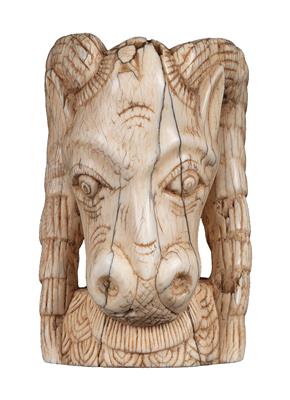Owo, Nigeria: an ivory ram’s head, called ‘Osamasinmi’, from a fertility altar in the city of Owo. Very rare.
Owo, Nigeria: an ivory ram’s head, called ‘Osamasinmi’, from a fertility altar in the city of Owo. Very rare.

Owo is the third and northernmost of the three old ‘sacred royal cities’ in Nigeria (Ife, Benin and Owo). In the course of its long history, Owo was often militarily occupied by Benin. The culture and art of Owo is also very similar to that of Benin. Frequently it is difficult to differentiate between works of art from Owo and those from Benin.
A special ‘invention’ of the culture and art of Owo are such ram’s heads with long, curved horns, called ‘Osamasinmi’. They did also exist in Benin, but rarely, and probably adopted from the traditional influence of the culture of Owo. These ‘Osamasinmi ram’s heads’ stood on their own altars and were provided with liquid sacrificial offerings. They were believed to increase the fertility of the fields and were used especially at the annual, major feast on the occasion of the harvest of the first yam roots. Normally, the ‘Osamasinmi ram’s heads’ are carved of wood and of larger size (c. 40 cm). The present ram, however, is made of ivory and is vertically pierced throughout. By means of this hole, it was stuck on to a wooden tenon and thereby affixed to an altar.
It displays three delicate, old cracks in its unusual, naturalistically fashioned face, and a continuous crack on the reverse, as well as small pieces broken off at the left horn and at the top of the head, here with an old original repair by means of an inserted small piece of ivory. Otherwise no damage. A fine, smooth shiny patina on the outside, thick, old craquelure on the lower cut surface, as well as a yellowish to light brown discolouration, typical of old ivory, on the inside of the continuous hole. Overall a highly rare, valuable ritual object (because made of ivory) that probably originates from a house altar of a high dignitary or chief in the city of Owo.
Dimensions: 14.5 cm x 10 cm x 9 cm.
Weight: 790 grams.
Late 19th century to around 1900. (ME) ASA
Provenance:
Austrian private collection.
Lit.:
‘Die Kunst des schwarzen Afrika’ by Kerchache, Paudrat, Stephan, ill. 80; ‘Encyclopedia of African Art and Culture’ by K.-F. Schädler, p. 495; ‘African Art in American Collections’ by Robbins & Nooter, ill. 580 (all ram’s heads made of wood)
Specialist: Erwin Melchardt
 Erwin Melchardt
Erwin Melchardt
+43-1-515 60-465
erwin.melchardt@dorotheum.at
20.02.2017 - 14:00
- Starting bid:
-
EUR 2,000.-
Owo, Nigeria: an ivory ram’s head, called ‘Osamasinmi’, from a fertility altar in the city of Owo. Very rare.
Owo is the third and northernmost of the three old ‘sacred royal cities’ in Nigeria (Ife, Benin and Owo). In the course of its long history, Owo was often militarily occupied by Benin. The culture and art of Owo is also very similar to that of Benin. Frequently it is difficult to differentiate between works of art from Owo and those from Benin.
A special ‘invention’ of the culture and art of Owo are such ram’s heads with long, curved horns, called ‘Osamasinmi’. They did also exist in Benin, but rarely, and probably adopted from the traditional influence of the culture of Owo. These ‘Osamasinmi ram’s heads’ stood on their own altars and were provided with liquid sacrificial offerings. They were believed to increase the fertility of the fields and were used especially at the annual, major feast on the occasion of the harvest of the first yam roots. Normally, the ‘Osamasinmi ram’s heads’ are carved of wood and of larger size (c. 40 cm). The present ram, however, is made of ivory and is vertically pierced throughout. By means of this hole, it was stuck on to a wooden tenon and thereby affixed to an altar.
It displays three delicate, old cracks in its unusual, naturalistically fashioned face, and a continuous crack on the reverse, as well as small pieces broken off at the left horn and at the top of the head, here with an old original repair by means of an inserted small piece of ivory. Otherwise no damage. A fine, smooth shiny patina on the outside, thick, old craquelure on the lower cut surface, as well as a yellowish to light brown discolouration, typical of old ivory, on the inside of the continuous hole. Overall a highly rare, valuable ritual object (because made of ivory) that probably originates from a house altar of a high dignitary or chief in the city of Owo.
Dimensions: 14.5 cm x 10 cm x 9 cm.
Weight: 790 grams.
Late 19th century to around 1900. (ME) ASA
Provenance:
Austrian private collection.
Lit.:
‘Die Kunst des schwarzen Afrika’ by Kerchache, Paudrat, Stephan, ill. 80; ‘Encyclopedia of African Art and Culture’ by K.-F. Schädler, p. 495; ‘African Art in American Collections’ by Robbins & Nooter, ill. 580 (all ram’s heads made of wood)
Specialist: Erwin Melchardt
 Erwin Melchardt
Erwin Melchardt
+43-1-515 60-465
erwin.melchardt@dorotheum.at
|
Buyers hotline
Mon.-Fri.: 10.00am - 5.00pm
kundendienst@dorotheum.at +43 1 515 60 200 |
| Auction: | Tribal Art |
| Auction type: | Saleroom auction |
| Date: | 20.02.2017 - 14:00 |
| Location: | Vienna | Palais Dorotheum |
| Exhibition: | 11.02. - 20.02.2017 |
